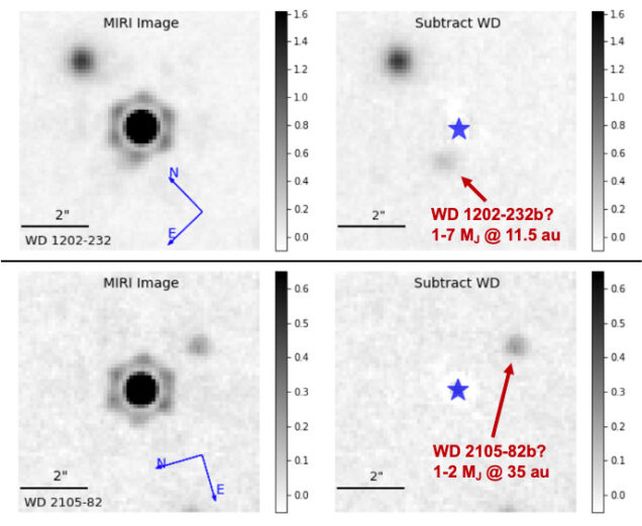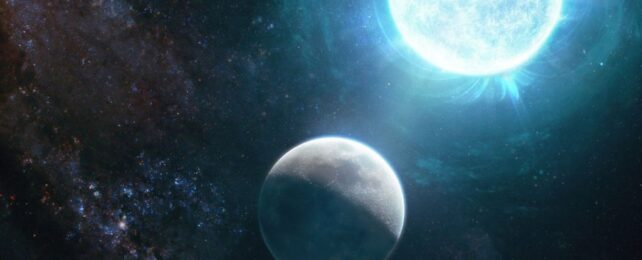No star dies quietly. Even the most peaceful of stellar deaths involve quakes, eruptions, and the shedding of huge amounts of mass into surrounding space.
This will be the eventual fate of the Sun, puffing up into a red giant that may extend as far as Mars before its outer material drifts free and its core collapses into an ultradense white dwarf.
What, then, happens to the remaining planets? Will their disrupted orbits send them wandering the galaxy, or will they be slurped up by the white dwarf? Could they even remain serenely undisturbed, orbiting a dead star as it slowly cools over trillions of years into a cold, inert lump?
Now, a new discovery is offering insight into the possible fate of the planets of the Solar System. Using the James Webb Space Telescope, astronomers have obtained direct images of what appear to be two gas giant exoplanets in orbit around white dwarf stars.
"If confirmed," writes a team led by astronomer Susan Mullally of the Space Telescope Science Institute (STScI), "these would be the first directly-imaged planets that are similar in both age and separation to the giant planets in our own Solar System, and they would demonstrate that widely separated giant planets like Jupiter survive stellar evolution."
The images are quite fabulous for a number of reasons. Usually, we don't actually see exoplanets directly. Although over 5,500 exoplanets have been confirmed at time of writing (and thousands more candidates have been detected), most of those detections are indirect. Astronomers observe the effects the exoplanet has on its host star, and infer its properties based on those effects.
That's because exoplanets are very small, very far away, and any light they reflect or emit is miniscule compared to the light of the star; our current technology, although it is improving, simply can't detect them.
But the JWST is the most powerful space telescope ever built, so Mullally and her team used it to look for white dwarf exoplanets.
They found what appear to be gas giant exoplanets orbiting two different white dwarf stars named WD 1202-232 and WD 2105-82 at distances of 34 and 53 light-years from Earth, respectively. It's unclear precisely how massive the exoplanets are, but the images place them somewhere between 1 and 7 times the mass of Jupiter. More precise masses could be obtained by studying the stars' subtle wobbles, known as their radial velocity.

What's more interesting is the orbital separation between the white dwarfs and their planets.
The exoplanet orbiting WD 1202-232 appears to be at a distance of 11.47 astronomical units; that's a little farther out than Saturn, which orbits the Sun at 9.5 astronomical units. And the exoplanet orbiting WD 2105-82 has an apparent orbital separation of 34.62 astronomical units, similar to Neptune's orbital distance of 30 astronomical units.
If the exoplanets are the same age as their host stars, this would mean that exoplanets with distances similar to those of the outer planets in the Solar System can survive the violent deaths of their stars and remain in orbit.
Only a scant handful of white dwarf exoplanets have been discovered to date, which means we don't have a great deal of information to draw upon when predicting the fate of the Solar System when the Sun dies. We do know, based on analysis of white dwarf atmospheres, that these dense stellar remnants can devour close planets, polluting the atmospheres with planetary material.
This discovery is yet to be confirmed – the two objects could be galaxies in the distant background – although the researchers think that is unlikely. This means that the two candidate worlds represent an important and key piece of the puzzle about what happens to a planetary system like our own when the star reaches the end of its life.
The team recommends follow-up surveys to pin down the nature of their fascinating find.
"If confirmed using common proper motion, these giant planets will represent the first directly imaged planets that are similar in age, mass, and orbital separation as the giant planets in our own solar system," they write.
"Future spectroscopy and multi-band imaging of these systems may be possible with JWST, which would improve the observational constraints on the physics and variety of cool giant planet models."
The research has been accepted for publication in The Astrophysical Journal Letters, and is available on arXiv.
